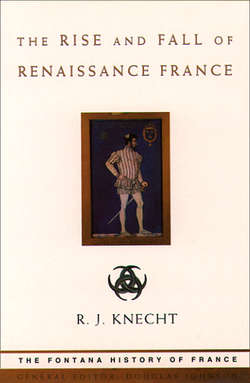Читать книгу The Rise and Fall of Renaissance France - R. Knecht J. - Страница 16
The ‘Mad War’
ОглавлениеThe princely revolts, which cast a shadow across the early years of Charles VIII’s reign, have sometimes been read as the sequel to the War of the Public Weal of 1465. The two movements, however, were quite different. The rising of 1465 had been aimed at Louis XI’s overthrow and had lasted only a few months. The Mad War (Guerre folle), by contrast, was not directed at Charles VIII but at the Beaujeus; it also developed surreptitiously over a period of two years, erupting in 1487. A major reason for the long gestation was the independence of the duchy of Brittany, which offered a safe haven to malcontents from the French court. The rising was given its pejorative name soon afterwards by the contemporary historian Paolo Emilio, in his De rebus gestis Francorum.
Brittany’s independence of France manifested itself in various ways. Duke Francis II had paid only a simple homage to King Louis XI which entailed none of the obligations customarily incumbent on a vassal to his suzerain; he had not even gone this far in respect of Charles VIII. Brittany seemed bent on becoming a second Burgundy. Yet it was poor, and militarily far inferior to its French neighbour; it could only hope to defend itself by calling in foreign help, especially from England. But paradoxically the duchy’s independence was undermined by its own subjects, for many Breton nobles chose to serve the king of France, attaching themselves to his court. They retained important estates in Brittany and longed to unite the duchy to the kingdom which provided them with offices, honours and wealth. Another Breton weakness was Duke Francis II, a feckless dilettante who became senile about 1484. His only offspring were two daughters, Anne and Isabeau. The affairs of the duchy fell into the hands of Pierre Landais, its treasurer and a much hated parvenu.
In October 1484 the Breton exiles in France came to an agreement at Montargis with the French government. They swore to recognize Charles VIII as their duke’s successor, should the latter die without male issue. The king, for his part, promised to respect Breton privileges and to arrange good marriages for the duke’s two daughters. Francis’s riposte was to take an oath from his subjects acknowledging his daughters as his heirs. On 23 November he also made a treaty with Louis d’Orléans aimed at freeing Charles VIII from Beaujeu tutelage. The duke, at the same time, won the support of a number of French malcontents and courted the Parisians. Early in 1485, Dunois, Orléans’s evil genius, produced a manifesto condemning the government’s financial management. Orléans begged Charles to emancipate himself from the Beaujeus and return to Paris. The king refused, whereupon Orléans left the capital and started raising troops. He appealed to all his friends, including Francis II, for armed assistance, but the first fires of rebellion were soon put out by the Beaujeus. In February, Charles VIII returned to Paris and measures were taken against the rebels: Orléans was deprived of his governorships of Ile-de-France and Champagne, and Dunois of that of Dauphiné. On 23 March the duke made his submission and was readmitted to the council.
Orléans, however, was biding his time. On 30 August he issued a new manifesto critical of the government’s financial policy. In league with him were Beaujeu’s brother Jean, Constable of Bourbon, the comte d’Angoulême, the comte d’Etampes, Cardinal Pierre de Foix, the sire d’Albret and, of course, Dunois. The rebels hoped to have a larger army than the Beaujeus, who had just sent 4000 men to help Henry Tudor gain the English throne; but their hopes were soon dashed. Charles VIII besieged Orléans and Dunois in Beaugency and within a week the revolt was over. By mid-September the duke was again penitent and had to accept royal garrisons in the towns of his apanage. Dunois lost his office of great chamberlain and was banished to Asti for a year. Bourbon and the other rebels also capitulated. The Peace of Bourges (2 November) gave France several months of domestic tranquillity.
In June 1486, Maximilian of Habsburg, who had recently been elected King of the Romans, launched a surprise attack on France’s northern border. It soon ran out of steam because Maximilian was, as usual, unable to pay his troops, but it triggered off another rebellion within France. The pretext was again fiscal: the Beaujeus had imposed a new crue de taille of 300,000 livres in October. In January 1487, Orléans joined Dunois in Brittany, but Charles VIII and Anne de Beaujeu decided to deal with the rebels in Guyenne before attending to Brittany. Their campaign, which lasted a month and a half, comprised a series of successful sieges. The leading rebel in the south-west, Charles d’Angoulême, surrendered on 19 March and was married off to Louise of Savoy. The future King Francis I was their son.
